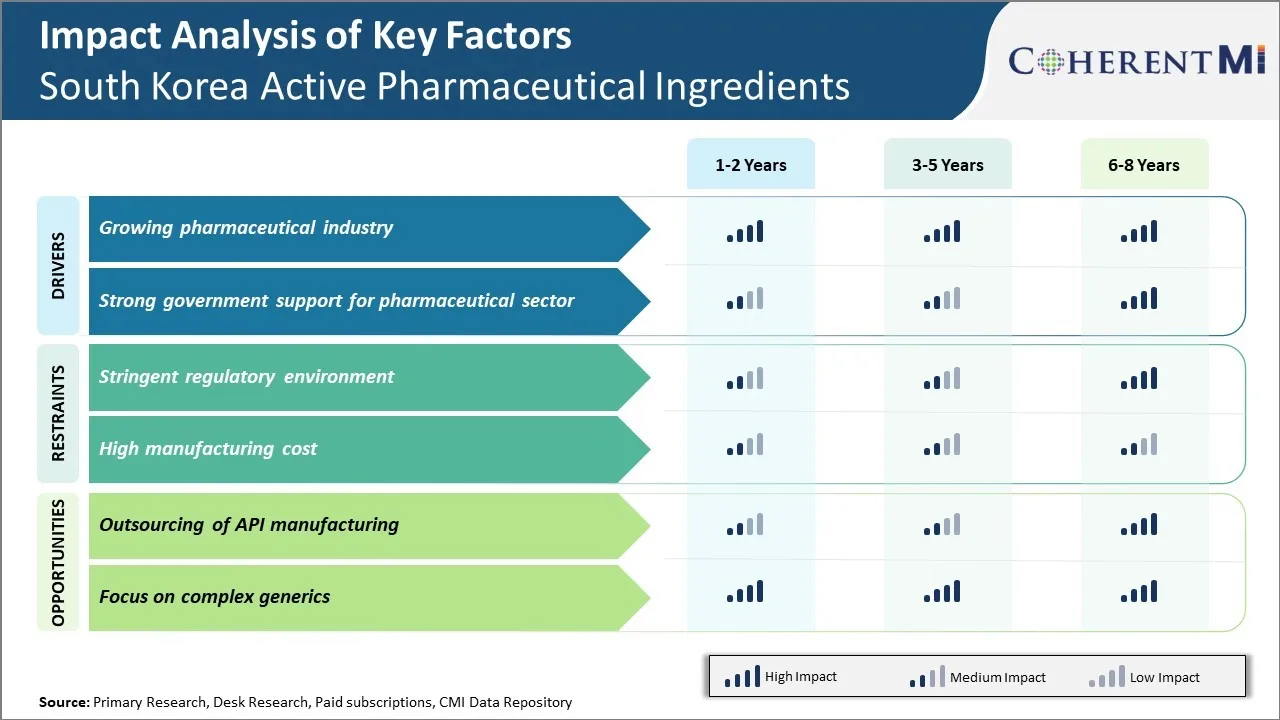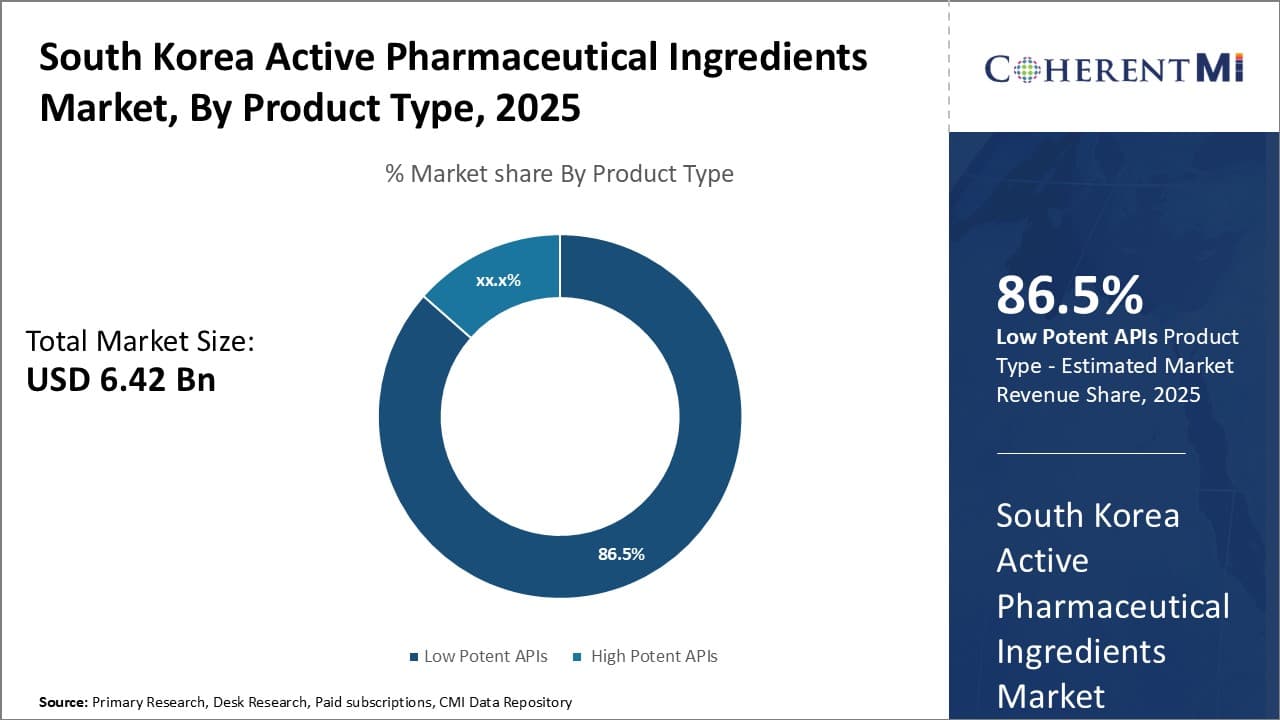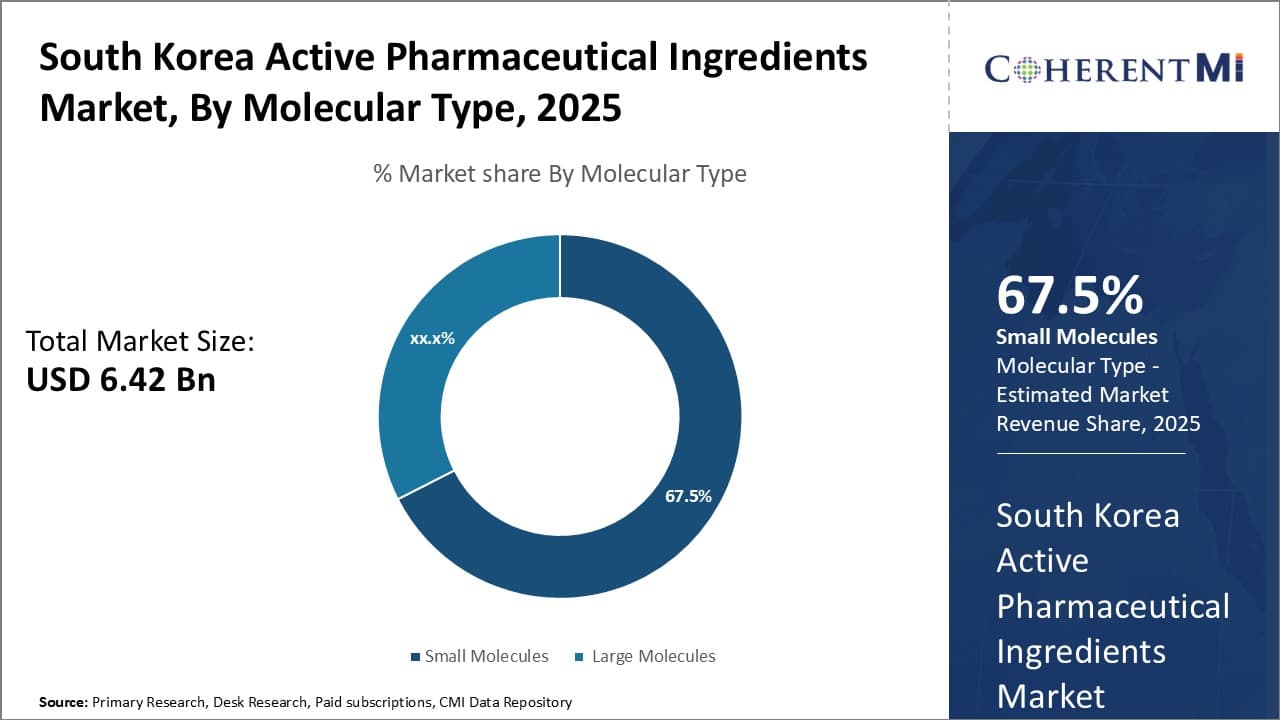

韓国アクティブ医薬品原料市場は、 2025年のUSD 6.42 Bn そして到達する予定 2032年までのUSD 9.22 Bn, 成長 2025年から2032年までの5.3%のCAGR。
市場成長は、慢性疾患の増加の優先順位と国における胃の人口の増加によって駆動されます。
市場規模(米ドル) Bn
CAGR5.3%
| 調査期間 | 2025-2032 |
| 推定の基準年 | 2024 |
| CAGR | 5.3% |
| 市場集中度 | Medium |
| 主要プレーヤー | Tevaの薬剤 株式会社インダストリーズ, キオンボファーマ, サモー 株式会社ファーマー, 代表取締役社長, ククジョン製薬株式会社 その他 |
市場ドライバー - 医薬品を成長させる 業界トップ
韓国の製薬産業は、過去10年間に途上国で途上国で成長し、医薬品開発・製造のグローバルリーダーとして誕生しました。 この拡大産業は、先進国で活躍する医薬品原料(API)市場を推進する主要なドライバーの1つです。
韓国国内の医薬品メーカーとして、幅広い疾患を治療するために新たな革新的な医薬品を開発・販売し、これらの製剤で利用される API の需要は、引き続き増加しています。 Celltrion、Hanmi Pharmaceuticals、Samsung Bioepisなどの主要な製薬会社は、複雑なAPIの生産を必要とするバイオロジックの研究に大きく投資しました。 また、政府は、研究開発活動の税制優遇措置のような施策を実施し、国内でさらなる製薬イノベーションを推進しています。
韓国の医薬品製造における先進療法の開発に重点を置き、今後数年間で API の需要が高まります。 例えば、世界中の多くのブロックブスター薬製品に関する特許が、バイオシミラー薬の発見に焦点を合わせるために医薬品会社を促しています。
市場ドライバ - 医薬品セクターのための強力な政府サポート
韓国は、医薬品分野における強力な政府支援により、近年、アクティブ医薬品原料(API)の主要製造拠点として誕生しました。 韓国政府は、医薬品製造における投資と革新を後押ししたいくつかの政策とインセンティブを実施しました。
主要なポリシーの中には、R&Dの支出のための重要な税金の休憩や、API製造工場をセットアップする企業のための優先融資が含まれます。 政府は、APIの承認プロセスを合理化し、国内企業がジェネリック医薬品を発売するのを早くします。 この規制援助は、製薬会社にとって大きな痛みのポイントに対処し、患者に対する薬物のアクセシビリティを促進します。
これらの介入の結果、サムスンバイオロジカル、Celltrion、Daewoongなどの多くの韓国のコングロマリスは、過去5年間にAPI施設を拡大して10億を注いでいます。 健康メトリクスと評価研究所のデータによると、韓国のGDPのシェアとしての健康増殖は、2011年に7.6パーセントから2018年に8.4パーセント増加しました。
 このレポートの詳細については、 無料サンプルコピーをダウンロード
このレポートの詳細については、 無料サンプルコピーをダウンロード
市場課題 – 厳格な規制環境
韓国の厳しい規制環境は、国のアクティブ医薬品原料(API)市場の成長に大きな課題を提唱しています。 食品医薬品安全(MFDS)の韓国省が保有する規制ガイドラインは非常に厳密で、APIメーカーをナビゲートするのは複雑です。 グッド・マニュファクチャリング・プラクティス(GMP)、製品品質基準、環境および安全規範に関するMFDSガイドラインの遵守は、時間と資本の実質的な投資を必要とします。
また、MFDSの承認を得て、新製造設備の設置や既存工場の拡大などは、長い工程です。 包括的なドキュメントとオンサイトの検査は、承認手順の一環として、さまざまな段階で必須です。
世界保健機関(WHO)のデータによると、2021年の韓国では、製造ライセンスの発行に時間がかかり、OECD平均を下回りました。 報告によると、韓国の当局は、他の先進国の320日間と比較して、新しい薬の生産工場へのライセンスを付与するために平均450日でした。
市場機会 – API 製造アウトソーシング
API製造アウトソーシングは、韓国のアクティブ医薬品原料(API)市場における成長に大きなチャンスを提供できます。 製薬業界は複雑さと専門医療に向け、大手製薬会社でも高度なAPIの開発が大きな課題となっています。 R&Dや製造施設に大きな投資が必要で、多くの企業が独立して受けられない場合があります。 アウトソーシングAPIの生産により、製薬会社は韓国の受託メーカーの専門製造能力を活かしながら、コア医薬品開発業務に注力できます。
韓国は、過去10年間に製薬業界に熟練した労働力とインフラを整備してきました。 この国は、複雑で特許保護された API の合成ルートをサポートする世界クラスの施設に在しています。 韓国の企業は、先進的な設備を買収し、グリーン化学と継続的なフロー方法論の専門知識を持つ才能をリクルートするために膨大な投資をしました。 これらの施設をアウトソーシングすることで、グローバル製薬メーカーは、コスト効率の高い方法でスケールアップ中の製品およびアドレス容量の問題のセキュリティを確保することができます。
 このレポートの詳細については、 無料サンプルコピーをダウンロード洞察、製品の種類によって:治療領域を渡る多様なアプリケーション
このレポートの詳細については、 無料サンプルコピーをダウンロード洞察、製品の種類によって:治療領域を渡る多様なアプリケーション
低い強力な API セグメントは、韓国のアクティブ医薬品原料市場を86.5%のシェアで支配し、治療領域全体で多様なアプリケーションに供給します。 これらの API は、さまざまな慢性およびシジブルな患者プールを備えた一般的な病気の処方で使用されます。 製造の広範なアクセシビリティと利便性は、ローポテント API をローカル製薬会社にとって主な選択肢にしました。
ローポテント API の需要が高い主要なコントリビューターは、韓国の高齢人口プロファイルです。 生涯薬を必要とする糖尿病、高血圧、関節炎などの慢性疾患はますます普及しています。 低い強力なAPIは費用効果が大きい方法でそのようなライフスタイルの病気を効果的に扱います。 また、日常的な健康問題を標的とした、多くのOTC薬のコア成分も配合しています。 これは、大規模なアドレス指定可能な人口とボルスタの一貫性のある要件を処理します。
従来型機器の合成を更に磨き上げることで、その人気が高まります。 ローカル製薬会社は、製品バスケットを多様化し、能力を最大限に活用するために、低強力なAPI機能を活用しています。 処方は、予測可能なサプライチェーンと許容コストのためにこれらも好みます。 低強力APIの広範囲なローカル生産は、国内ニーズの主要部分を満たしています。 国内での信頼できる調達は、供給の信頼性を高めます。
 このレポートの詳細については、 無料サンプルコピーをダウンロード
このレポートの詳細については、 無料サンプルコピーをダウンロード
分子型によるインサイト:多様な分子フレームワークにおける多様性
小さい分子 多様な分子枠組みを横断して、韓国の有効成分部門で最大67.5%のAPIアカウント。 さまざまな薬理学的プロファイルを細かく調整する柔軟性により、より広範な治療関連性が得られます。
小さな分子の重要な強さは、複数のターゲットと経路に合った適応性です。 これは、神経学から心血管まで疾患のクラスの範囲のための候補を設計することができます。 彼らの適度なサイズはまた目的の活動および安全基準を達成するためにphysico化学的特性の最適化を促進します。 この汎用性は、研究者が以前に困難な病気空間のために新しいターゲットを追求することを可能にします。
汎用性とは別に、小さな分子は、最適化された選択性と効力の利点を提供します。 精度でターゲットタンパク質を選択的にヒットする能力は、それらを慢性および急性条件全体で有効にします。 高度な合成とプロセス R&D は、小型分子の選択性効力プロファイルを強化します。
小さな分子量も関連技術の成熟から導きます。 合成および特徴化方法は、バイオロジックと比較して十分に確立されます。 これにより、API合成を含む完全な小さな分子値チェーンをローカライズすることができます。 このようなローカライズされた信頼性の高いサプライチェーンは、韓国の薬局セクターの優先順位を下回っています。
韓国のアクティブな医薬品成分市場で活動する主要なプレーヤーには、Teva Pharmaceutical Industries Ltd.、Kyongbo Pharm、Samoh Pharmが含まれます。 Co.、Ltd.、Shinpoong.co、.ltd、Kukjeon Pharmaceutical Co.、Ltd.、Hanmi Pharm.co。、Ltd。、Abcr GmbH、Polpharma、Lupine、およびJeil Pharmaceutical Co。、Ltd。 
p> p> p>購入オプションを検討しますか?このレポートの個々のセクション?
Ghanshyam Shrivastava - 経営コンサルティングとリサーチの分野で 20 年以上の経験を持つ Ghanshyam Shrivastava は、プリンシパル コンサルタントとして、生物製剤とバイオシミラーに関する幅広い専門知識を持っています。彼の主な専門知識は、市場参入と拡大戦略、競合情報、さまざまな治療カテゴリと API に使用されるさまざまな医薬品の多様なポートフォリオにわたる戦略的変革などの分野にあります。彼は、クライアントが直面する主要な課題を特定し、戦略的意思決定能力を強化するための堅牢なソリューションを提供することに優れています。彼の市場に関する包括的な理解は、リサーチ レポートとビジネス上の意思決定に貴重な貢献をします。
Ghanshyam は、業界カンファレンスで人気の高い講演者であり、製薬業界に関するさまざまな出版物に寄稿しています。
韓国の有効成分市場は、製品タイプ(低効力API、高効力API)、分子タイプ(小分子、大分子)、製剤(経口、局所、注射剤、点滴剤)、用途(糖尿病、腫瘍学、心血管、中枢神経系、鎮痛剤、眼科、呼吸器、皮膚科...
韓国の医薬品有効成分市場
韓国の有効成分市場はどれくらいの大きさですか?
韓国のアクティブ医薬品原料市場は、2025年のUSD 6.42で評価され、2032年までのUSD 9.22億に達すると予想されます。
韓国のアクティブ医薬品原料市場成長を促進する主要な要因は何ですか?
製薬産業の成長と医薬品業界への強い政府支援は、韓国の有効成分市場を牽引する主要な要因です。
韓国の有効な薬剤の原料の市場の主要なプロダクト タイプは何ですか。
主要な製品種別セグメントは、強力なAPIです。
韓国のアクティブ医薬品原料市場における主要な選手は?
Tevaの薬剤 産業株式会社、Kyongbo Pharm、SAMOH 株式会社ファーマ シンポオン株式会社、ククジョン製薬株式会社、ハンミファーマ株式会社 株式会社アブク・ファーマ・ファーマ・ルピン・ジェイル・ファーマシータク株式会社 主な選手です。
韓国のアクティブ医薬品原料の市場は?
韓国活性医薬品原料のCAGR 市場は2025-2032から5.3%であるために写っています。